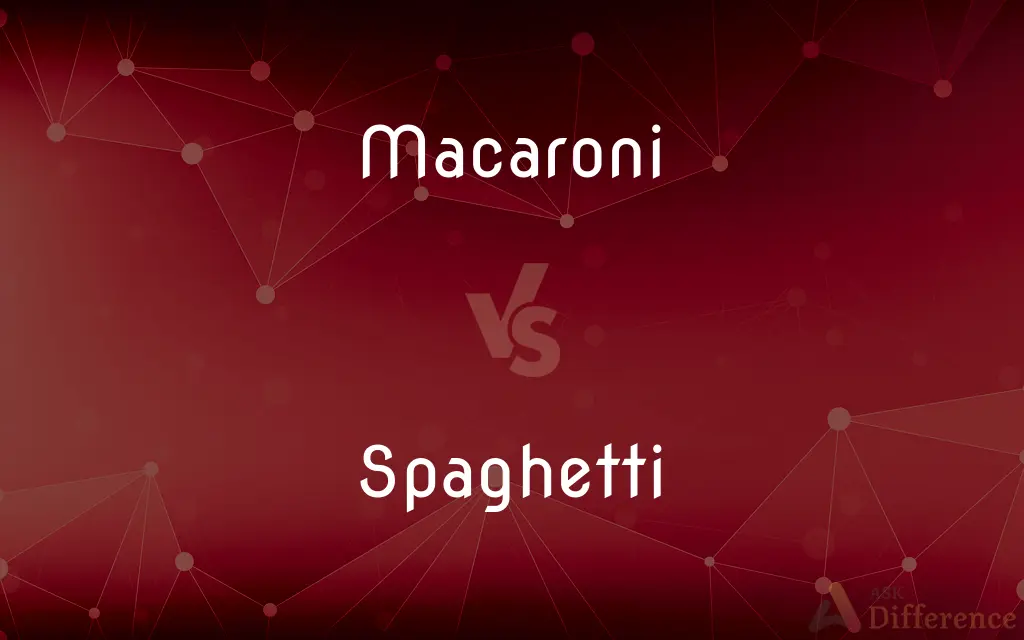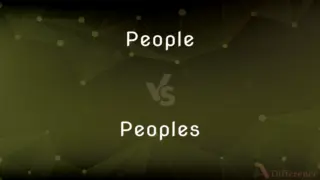Macaroni vs. Spaghetti — What's the Difference?
By Tayyaba Rehman — Updated on October 11, 2023
Macaroni is short, tubular pasta; Spaghetti is long, thin, cylindrical pasta. Both are Italian staples.

Difference Between Macaroni and Spaghetti
Table of Contents
ADVERTISEMENT
Key Differences
Macaroni and Spaghetti are both popular types of pasta, but they have distinct shapes and uses. Macaroni is typically a short, hollow pasta, often curved in shape. It's frequently used in dishes like mac and cheese or paired with cheese-based sauces. On the other hand, Spaghetti is recognized by its long, thin, cylindrical shape, often served with tomato-based sauces or meatballs.
While both Macaroni and Spaghetti are made from durum wheat semolina, their shapes give them different textures when cooked. The tubular structure of Macaroni allows it to hold sauces well, making it ideal for creamy preparations. Spaghetti, being long and thin, pairs well with lighter sauces, ensuring each strand is coated uniformly.
It's also worth noting the cultural impact of these pastas. Macaroni has become synonymous with comfort food in many Western cultures, especially the United States. Dishes like mac and cheese are beloved by many. Spaghetti, on the other hand, has a rich history in Italian cuisine, with iconic dishes like spaghetti carbonara or spaghetti bolognese showcasing its versatility.
In terms of preparation, Macaroni and Spaghetti can sometimes require different cooking times due to their sizes and thicknesses. It's essential to follow the package instructions or test for desired doneness. Lastly, while both can be found in most supermarkets worldwide, they each have unique variations and types that might be more prevalent in specific regions or cultures.
Comparison Chart
Shape
Short, often curved, tubular pasta.
Long, thin, cylindrical pasta.
ADVERTISEMENT
Common Uses
Cheese-based dishes like mac and cheese.
Dishes with lighter sauces, e.g., spaghetti bolognese.
Texture
Holds sauces well due to its tubular structure.
Coats uniformly with sauces due to its thinness.
Cultural Impact
Symbol of comfort food in the U.S.
Iconic in Italian cuisine.
Cooking Times
Can vary, often shorter due to size.
Typically longer due to length and thickness.
Compare with Definitions
Macaroni
A versatile pasta used in various cuisines.
The macaroni salad is a hit at picnics.
Spaghetti
Often used to describe something tangled or complex.
The wires behind the TV looked like spaghetti.
Macaroni
A short, hollow pasta, often curved.
I made a creamy macaroni and cheese for dinner.
Spaghetti
A type of pasta made primarily from wheat and water.
Whole wheat spaghetti is a healthier option.
Macaroni
A dish, particularly in the U.S., made with this pasta and cheese.
Macaroni is her favorite comfort food.
Spaghetti
A staple in many Western and Italian cuisines.
Tonight, we're making garlic oil spaghetti.
Macaroni
A type of pasta made from durum wheat.
This brand offers gluten-free macaroni.
Spaghetti
A long, thin, cylindrical pasta of Italian origin.
She twirled her spaghetti around her fork.
Macaroni
Macaroni (, Italian: maccheroni) is dry pasta shaped like narrow tubes. Made with durum wheat, macaroni is commonly cut in short lengths; curved macaroni may be referred to as elbow macaroni.
Spaghetti
Spaghetti (Italian: [spaˈɡetti]) is a long, thin, solid, cylindrical pasta. It is a staple food of traditional Italian cuisine.
Macaroni
Pasta in the shape of narrow tubes.
Spaghetti
Pasta made in solid strings, between macaroni and vermicelli in thickness.
Macaroni
An 18th-century British dandy who imitated continental fashions.
Spaghetti
Pasta in long, often thick strands.
Macaroni
Pl. macaroni Pasta in any of various hollow shapes, especially short curved tubes.
Spaghetti
(Electricity) A slender tube of insulating material that covers bare wire.
Macaroni
A well-traveled young Englishman of the 1700s and 1800s who affected foreign customs and manners.
Spaghetti
A type of pasta made in the shape of long thin strings.
Macaroni
A fop.
Spaghetti
(by extension) A dish that has spaghetti as a main part of it, such as spaghetti bolognese.
Macaroni
(uncountable) A type of pasta in the form of short tubes; sometimes loosely, pasta in general.
Spaghetti
(informal) Any type of pasta.
Macaroni
A fop, a dandy; especially a young man in the 18th century who had travelled in Europe and who dressed and often spoke in an ostentatiously affected Continental manner.
Spaghetti
(informal) Electrical insulating tubing.
Macaroni
(obsolete) A macaroon.
Spaghetti
(informal) Anything tangled or confusing.
Macaroni
(historical) Chic, fashionable, stylish; in the manner of a macaroni.
Spaghetti
(countable) A spaghetti western.
Macaroni
Long slender tubes made of a paste chiefly of a wheat flour such as semolina, and used as an article of food; a form of Italian pasta.
Spaghetti
Spaghetti code.
Macaroni
A medley; something droll or extravagant.
Spaghetti
To become, or appear to become longer and thinner.
The cables spaghettied onto the shoulder of the technician.
Macaroni
A sort of droll or fool.
Spaghetti
To stretch to become longer and thinner.
He spaghettied the referee when he landed on him.
Macaroni
A finical person; a fop; - applied especially to English fops of about 1775, who affected the mannerisms and clothing of continental Europe.
Spaghetti
A variety or macaroni made in tubes of small diameter.
Macaroni
The designation of a body of Maryland soldiers in the Revolutionary War, distinguished by a rich uniform.
Spaghetti
Pasta in the form of long strings
Macaroni
A British dandy in the 18th century who affected Continental mannerisms;
Yankee Doodle stuck a feather in his cap and called it macaroni
Spaghetti
An Italian dish made with this pasta and tomato sauce.
Spaghetti and meatballs is a classic dinner choice.
Macaroni
Pasta in the form of slender tubes
Macaroni
Historically, a dandy or fop.
The song mentioned a Yankee Doodle Macaroni.
Common Curiosities
What type of sauce typically goes with Macaroni?
Macaroni often pairs with creamy or cheese-based sauces.
What dishes are commonly made with Spaghetti?
Dishes like spaghetti bolognese, spaghetti carbonara, and spaghetti with meatballs are popular.
Is Macaroni the pasta used in "mac and cheese"?
Yes, "mac" in "mac and cheese" stands for Macaroni.
Are both Macaroni and Spaghetti Italian?
Yes, both are staples in Italian cuisine but have found popularity worldwide.
How long does it typically take to cook Spaghetti?
Cooking times vary, but Spaghetti often takes 8-12 minutes; always check the package or test for doneness.
Can Spaghetti be used in soups?
Yes, Spaghetti can be broken into shorter lengths and added to soups.
Can Macaroni be substituted for Spaghetti in recipes?
While possible, the texture and sauce interaction will differ due to their distinct shapes.
What is the primary shape difference between Macaroni and Spaghetti?
Macaroni is short and tubular, often curved, while Spaghetti is long and thin.
Are there whole grain versions of Macaroni available?
Yes, many brands offer whole grain or whole wheat Macaroni options.
Is Spaghetti the thinnest type of pasta?
No, there are thinner pastas, like angel hair or capellini.
Which is quicker to cook, Macaroni or Spaghetti?
Cooking times can vary, but Macaroni often cooks faster due to its shorter size. Always check package instructions.
Why is Macaroni often used in pasta salads?
Its shape holds onto ingredients and dressings well, making it a favorite for salads.
What does "al dente" mean when cooking Spaghetti?
"Al dente" is Italian for "to the tooth," meaning pasta is cooked so it's still firm when bitten.
Are Macaroni and Spaghetti typically made from the same ingredients?
Generally, yes. Both are often made from durum wheat semolina and water.
What's the significance of Spaghetti in Italian culture?
Spaghetti has a rich history in Italian cuisine and is central to many iconic dishes.
Share Your Discovery

Previous Comparison
Her vs. Him
Next Comparison
People vs. PeoplesAuthor Spotlight
Written by
Tayyaba RehmanTayyaba Rehman is a distinguished writer, currently serving as a primary contributor to askdifference.com. As a researcher in semantics and etymology, Tayyaba's passion for the complexity of languages and their distinctions has found a perfect home on the platform. Tayyaba delves into the intricacies of language, distinguishing between commonly confused words and phrases, thereby providing clarity for readers worldwide.














































